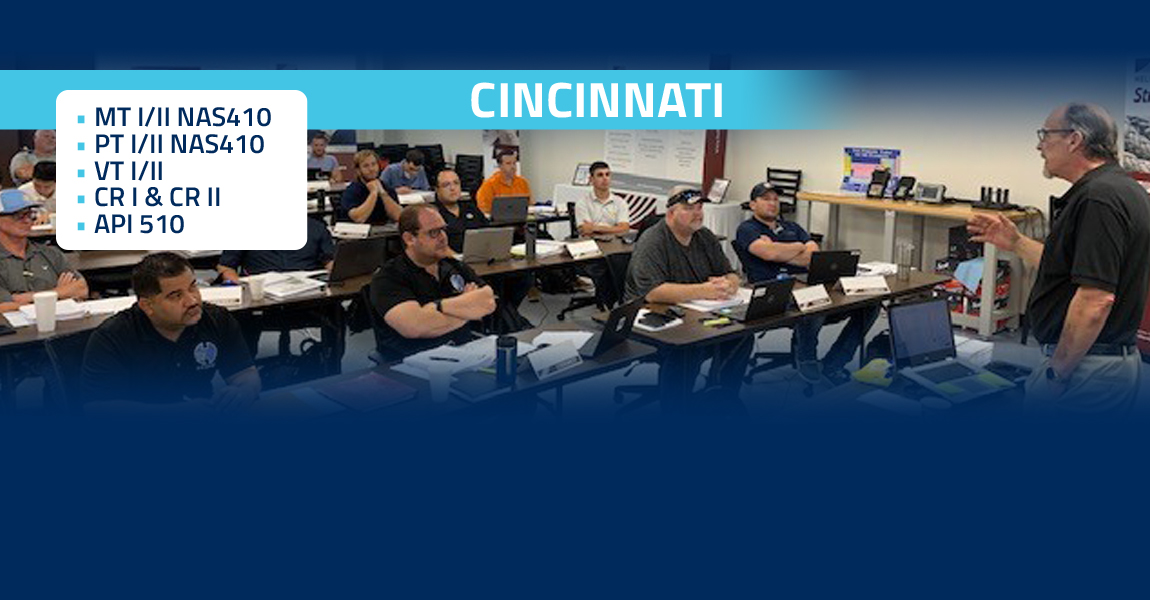NDT Certification
“How Do I Become NDT Certified?”
There are multiple steps to become certified in an NDT method: training, experience and examination. A common misconception is that NDT courses certify a student upon completion, however, taking an NDT course does not certify a student in an NDT method. The course only satisfies the classroom training requirement in the multistage certification process.
If that’s so, then how do you become certified?
Certification In A Nutshell
Certification is typically done by the employer (There is another option, see Third Party Certification in the “DETAILED INFORMATION ABOUT CERTIFICATION” Section below).
The following must be completed to become certified:
A. Classroom Training – The part Hellier does.B. Experience – The part you get by working on the job with a certified person in the method for which certification is sought.
C. Examination – After the classroom training and experience have been accomplished you will be given four different examinations:
1. General – Tests your general knowledge in the theory of the method.
2. Specific – Tests your ability to apply the knowledge in procedures, specifications, codes and use of the equipment used by the employer.
3. Practical – Tests your ability to actually use the equipment and perform the test as well as to evaluate test samples for acceptability.
4. Vision – You will be given a vision exam on an annual basis to test your visual acuity.
Detailed Information About Certification
This section offers more detailed information about the certification process.
There are several steps to become fully certified in an NDT method.I. – Select an NDT program
II. – Training Hours/Education
III. – Experience
IV. – Certification Exam (Company-specific or Third-Party)
I. Select An NDT Program
To become NDT Certified, you must first select an NDT program. Most employers have already selected a program so ask your company which one they participate in. The most common programs in North America: NAS 410, SNT-TC-1A, CP 189, ISO 9712, ACCP and CGSB. Each program will outline the various requirements for certification.
II. Training Hours/Education
Just about all NDT programs require training based on topical training course outlines taught by subject-matter experts. Training must cover the Body of Knowledge and fulfill requirements for each level of qualification defined by the NDT program.
To view the amount of Training Hours necessary to become certified, visit the ASNT Certification webpage, select the desired ASNT certification program and view the “Initial Qualification Requirements.”
III. Experience
ASNT requires “Hours in Method” and “Total Hours in NDT” experience in order to be certified. The “Hours in Method” refers to the amount of experience in a specific method, while “Total hours in NDT” refers to the amount of experience in all NDT methods. The amount of experience required (Method or Total) varies depending on the method and the program you wish to participate in.
To view the amount of Experience necessary to become certified, visit the ASNT Certification webpage, select the desired ASNT certification program and view the “Initial Qualification Requirements.”
IV. Certification Exam
Third Party Certification vs Employer Certification
Employer-based certification: Employers are responsible for NDT training, testing and documentation for employees according to their qualification and certification procedure. The employer will provide a formal certificate or letter authorizing their employee to perform NDT tasks, and certification will expire after a period of time (typically 3 or 5 years) or when an employee leaves the company. An Employee also loses certification if he/she no longer meets the company requirements, for example no current eye exam or not passing a re-certification exam.
Central certification (Third Party):Qualification examinations are administered by an independent third-party certification body based on a central certification standard. Candidates must provide documentation of training and experience and a certificate will be issued if the examination is successfully completed. The advantage is that employees maintain certification after leaving a company, but each employer has a choice whether to accept third-party certificates as proof of qualification or not.
The exams commonly associated with certification are:1. General – Tests your general knowledge in the theory of the method.
2. Specific – Tests your ability to apply the knowledge in procedures, specifications, codes and use of the equipment used by the employer.
3. Practical – Tests your ability to actually use the equipment and perform the test as well as to evaluate test samples for acceptability.
4. Vision – You will be given a vision exam on an annual basis to test you visual acuity.
If you need assistance meeting your training needs, please contact our local offices! We’ll be happy to help you.
For more information about ASNT certification, visit the ASNT NDT Certification Systems webpage.
For information about the CGSB / 9712 certification program, visit the NRCan NDT Webpage.
If you are an Employer and you need assistance developing a certification program, we have an Authorized Independent Outside Agency (AIOA) Service available.









